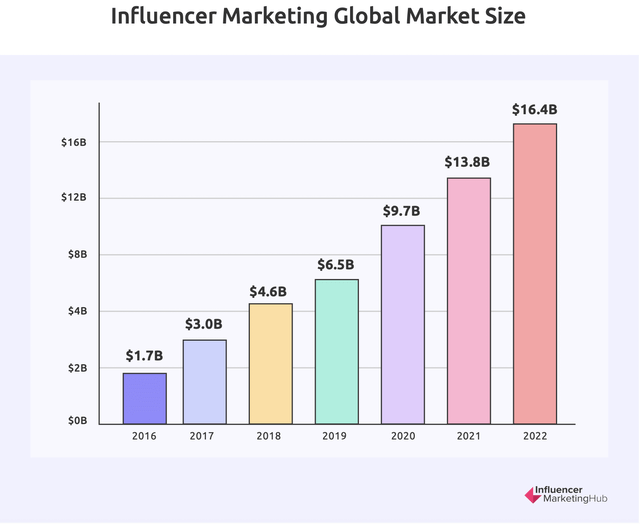B4LLS
Amazon (NASDAQ:AMZN) has successfully cemented its position on top of the e-commerce industry, which has been conducive to offering highly-effective advertising solutions, enabling the company to take advertising market share from social media giants like Google’s (GOOG) YouTube and Meta Platforms (META). Social media websites have been striving to transform into shopping destinations in a bid to better attract purchase-minded web visitors, as well as encourage digital merchants to list products on their platforms. Amazon has not taken these challenges lightly, and has been striking back with its own social commerce endeavors, the latest of which is the launch of ‘Inspire’.
Social media platforms start off as sources of entertainment, and become monetizable through selling ad spaces. The wide-audience accessibility offered by these platforms has also given rise to social media stars with extensive follower-bases. This in turn has created a new marketing avenue, enabling these new-age celebrities to leverage their influence over their followers, and endorse brands’ products to earn lucrative commissions. The growth of influencer marketing enables social media companies to better attract purchase-minded web visitors to their platforms.
Influencer marketing is a rapidly growing industry, and has become an increasingly important marketing avenue in the digital economy. Its global market size reached $13.8 billion in 2021, and is expected to grow to $16.4 billion in 2022.
Note: the figure for 2022 is a projected value. (Influencer Marketing Hub)
To capitalize on the fast-growing Influencer marketing industry, Amazon has been continuously advancing its own social commerce capabilities. One of its main initiatives has been the launch of its ‘Amazon Influencer Program’ in 2017, exclusively open to popular social media stars from platforms such as YouTube, TikTok and Instagram. The program enables influencers to promote Amazon’s products through their social media channels, including links to the influencers’ curated storefronts on the Amazon website, in exchange for commissions on product sales. Moreover, the program enables Amazon sellers to reach new audiences in inspiring manners, allowing them to build relations with influencers directly and make their products stand out. These social commerce initiatives are essential to maintain the appeal of listing products on Amazon, and mitigate the risk of losing sellers to rising competitors. Amazon’s latest social commerce venture is the launch of ‘Inspire’.
Inspire: Amazon’s latest social commerce initiative
The global rise of TikTok has sent social media giants scrambling to replicate its success by introducing their own short-form video features, including YouTube Shorts and Facebook/ Instagram Reels. While Google and Meta have not been able to adequately monetize their TikTok-clones through advertising so far, their new features do offer compelling potential for delivering more effective ad solutions, as “ads between short-form videos that appear in the same format as the organic [content] feel less intrusive by blending in with other videos”, thereby offering advertisers a better avenue for generating impressions.
Recognizing this potential, and to keep up with rising social commerce trends, Amazon launched ‘Inspire’ earlier this month. ‘Inspire’ is a feed, similar to TikTok and Instagram feeds, consisting of short-form videos and photos shared by influencers and brands to induce consumers to discover and buy products from the Amazon marketplace. The ‘Inspire’ feed also offers Amazon sellers a more exciting avenue to showcase their products and be discovered, in contrast to the mundane layout of products in Amazon search results, which tends to limit brands’ ability to stand out.
A key attraction of marketing products on social media platforms is the ability for merchants to learn how the audience is interacting with its promotional content. Consumers’ likes and comments on shopping content offers advertisers real-time insights into how their products are perceived by the audience. Hence, Amazon’s ‘Inspire’ feature serves as a key counteractive strategy to offset the risk of digital merchants preferring to list and market their products on social media platforms, as opposed to the Amazon marketplace. Engagement with content on ‘Inspire’ should allow Amazon sellers to learn more about consumers’ tastes and shopping habits, enabling them to deliver products that better meet consumers’ preferences. Therefore, ‘Inspire’ strives to keep both shoppers and sellers engaged on the Amazon platform, conducive to increasing Third-party seller services revenue (its second-largest revenue segment).
Traditionally, Amazon serves as a shopping search engine. Consumers typically visit the website and search for specific products they need. This enables Amazon to learn about how consumers browse and compare products, and feeds its ad re-targeting strategies to improve conversion rates for advertisers. However, once a consumer purchases the item they need, Amazon can’t anticipate consumers’ future shopping needs and learn more about shopping trends until the next time they use the Amazon search engine. The discoverability aspect of ‘Inspire’ will enable Amazon to learn more about consumers’ shopping preferences. Moreover, what content on the ‘Inspire’ feed will be determined by users choosing from over 20 interests when they first visit the feature on the Amazon App, and eventually by the data gathered through tracking users’ engagement (likes and comments) with the shoppable content. Consequently, ‘Inspire’ allows Amazon to learn more about shoppers’ interests beyond search activity, enabling the company to better anticipate future shopping trends, thereby delivering more effective ad solutions and potentially augmenting e-commerce activity through the platform, increasing both Advertising and Third-party seller services revenue.
‘Inspire’ is certainly not Amazon’s first attempt at social commerce. The e-commerce giant has been striving to create a Pinterest (PINS)-like offering through what eventually became ‘Interesting Finds’, and also offers Amazon Live, its live-stream shopping service enabling influencers and brands to host QVC-like shopping events.
In fact, Amazon has already attempted something similar to ‘Inspire’ before, with the launch of Amazon Spark in 2017. The feature strived to emulate Instagram through a feed of shoppable photos and stories, posted by Spark users themselves. It was eventually shut down in 2019 as it failed it pick up meaningful engagement. Only Amazon Prime members could post on Spark, with non-Prime members simply being allowed to browse (without being able to post or comment), which undermined the scope for engagement. Learning from past mistakes, ‘Inspire’ is a lot more open and engaging, inviting a mix of influencers, brands, and customers to post on the feed. Moreover, the company also has a relatively more established Influencer Program today, compared to a few years ago. Unlike Spark, ‘Inspire’ offers a new avenue for Amazon Influencers to earn sales commissions, putting it in a better position to induce more shoppable content sharing, and potentially driving more engagement and sales through the feature.
Counteractive factors
People visit social media platforms to connect with people, engage with creators and seek entertainment, and ads are delivered as part of a mix of different content. Users watch short-form videos primarily for entertainment, and merchants using short-form video formats to advertise between TikTok videos are aptly designing their ads to blend in with other organic content to generate more seamless product impressions, rather than an intrusive ad experience. On the other hand, Amazon’s ‘Inspire’ does not cater to people’s entertainment needs, but rather is solely focused on raising product awareness and inducing purchases. Due to the nascency of this type of advertising, the audience scope and willingness to watch back-to-back product promotional content is unclear, which gives investors reason to moderate their expectations until Amazon can prove the effectiveness of this feature to increase sales for Amazon sellers.
Furthermore, Amazon suffers from a long-standing trust issue. The e-commerce giant has faced well-publicized anti-trust litigations for its unethical business practice of using commercial data of third-party sellers to bolster its own line of products, essentially putting these merchants out of business. Small businesses invest a lot of time, energy and resources into creating successful products. The exploitation of this data against them impedes their ability to generate income for business survival. From a Socially Responsible Investing [SRI] standpoint, this is disheartening for investors that refuse to profit from unethical business practices. Moreover, while enhanced consumer engagement on ‘Inspire’ could indeed offer Amazon sellers more valuable insights into shoppers’ preferences, they continue to face the lingering threat of Amazon using advanced data analytics (unavailable to sellers) to enhance its private label offerings and more vigorously compete against smaller retailers. Consequently, despite Amazon’s social commerce advancements, trust issues moderate the threat Amazon poses to social media giants, as certain digital merchants may continue to prefer listing and marketing their products through social media platforms, to avoid the risk of their commercial data being used against themselves.
Social commerce is a fast-growing market; according to Grand View Research, it is “anticipated to reach USD 6.2 trillion by 2030, growing at a CAGR of 30.8% from 2022 to 2030”. Amazon’s success as an e-commerce platform and consequent recurring stream of purchase-minded web visitors positions it well to capitalize on the secular growth trend we are witnessing in the social commerce industry, but its trust-related short-comings and the general nascency of this product marketing avenue gives investors reasons to subdue their expectations.
Summary
Social media giants like TikTok, Instagram and YouTube have been trying to become e-commerce destinations. Amazon has been striking back through its own social commerce endeavors. Relative to previous attempts, ‘Inspire’ is better positioned to succeed, as it is more open and engaging, and benefits from a more well-established Influencer Program, offering a new monetization avenue to encourage social media stars to produce and share creative and promotional content. While the new feature is indeed an essential advancement to fend off rising competitive threats from social media platforms, Amazon’s short-comings related to trust and the nascency of this product marketing style gives investors reasons to moderate their expectations.
Any buying or selling decisions in Amazon stock should take into consideration all business divisions/ product lines aggregately. Given that this article focuses particularly on its social commerce segment, a neutral ‘hold’ rating will be assigned to the stock.


Be the first to comment